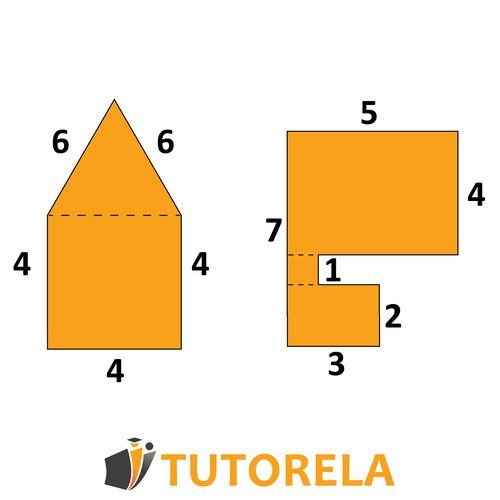When students hear the words "compound shapes", they usually feel uncomfortable. Just before you also ask yourself: "Oh, why this again?", you should be aware that there is no real reason. Describing shapes as compound doesn't really make them so. As it turns out calculating areas and perimeters of compound shapes is in fact relatively straightforward.
Area of Rectangle & Complex Shapes Practice Problems
Master rectangle area calculations and decompose complex shapes into familiar rectangles. Practice with step-by-step examples and build confidence solving geometry problems.
- Calculate rectangle area using length × width formula
- Decompose complex shapes into familiar rectangles
- Apply rectangle properties to find missing dimensions
- Add and subtract rectangle areas in composite shapes
- Solve real-world rectangle area word problems
- Master the puzzle method for complex shape areas
Understanding Area of a Rectangle
How do we calculate the area of complex shapes?
You will be introduced to Complex shapes only after you learn various shapes in geometry. The reason these shapes are complex is due to the fact that they are slightly different from those you've come to know. In each complex shape, additional shapes that you need to identify are hidden. Dividing the complex shape into several different (and familiar) shapes will allow you to answer the question of how to calculate the area of complex shapes.
The trick: extract a familiar shape from within the complex shape
So how do we answer the question of how to calculate the area of complex shapes? First, you need to identify familiar shapes within the complex shape. An example of this: a rectangle. As you know, each shape has properties that you are familiar with, so within the complex shape itself, you can apply the properties of the familiar shape and thus calculate areas and perimeters.
After completing the missing data (according to the properties of each shape, for example: rectangle), you can complete the "puzzle", identify additional data that is revealed to you, and thus calculate the area of the complex shape. When calculating the area of complex shapes, you will often need to perform simple arithmetic operations such as division and addition (mainly for sides in the shape) - all based on the unique properties of each shape.

Practice Area of a Rectangle
The trapezoid ABCD is shown below.
Base AB = 6 cm
Base DC = 10 cm
Height (h) = 5 cm
Calculate the area of the trapezoid.
Examples with solutions for Area of a Rectangle
Look at the rectangle ABCD below.
Side AB is 6 cm long and side BC is 4 cm long.
What is the area of the rectangle?
Remember that the formula for the area of a rectangle is width times height
We are given that the width of the rectangle is 6
and that the length of the rectangle is 4
Therefore we calculate:
6*4=24
Answer:
24 cm²
Look at the rectangle ABCD below.
Side AB is 4.5 cm long and side BC is 2 cm long.
What is the area of the rectangle?
We begin by multiplying side AB by side BC
We then substitute the given data and we obtain the following:
Hence the area of rectangle ABCD equals 9
Answer:
9 cm²
Look at rectangle ABCD below.
Side AB is 10 cm long and side BC is 2.5 cm long.
What is the area of the rectangle?
Let's begin by multiplying side AB by side BC
If we insert the known data into the above equation we should obtain the following:
Thus the area of rectangle ABCD equals 25.
Answer:
25 cm²
The triangle ABC is given below.
AC = 10 cm
AD = 3 cm
BC = 11.6 cm
What is the area of the triangle?
The triangle we are looking at is the large triangle - ABC
The triangle is formed by three sides AB, BC, and CA.
Now let's remember what we need for the calculation of a triangular area:
(side x the height that descends from the side)/2
Therefore, the first thing we must find is a suitable height and side.
We are given the side AC, but there is no descending height, so it is not useful to us.
The side AB is not given,
And so we are left with the side BC, which is given.
From the side BC descends the height AD (the two form a 90-degree angle).
It can be argued that BC is also a height, but if we delve deeper it seems that CD can be a height in the triangle ADC,
and BD is a height in the triangle ADB (both are the sides of a right triangle, therefore they are the height and the side).
As we do not know if the triangle is isosceles or not, it is also not possible to know if CD=DB, or what their ratio is, and this theory fails.
Let's remember again the formula for triangular area and replace the data we have in the formula:
(side* the height that descends from the side)/2
Now we replace the existing data in this formula:
Answer:
17.4
What is the area of the given triangle?
This question is a bit confusing. We need start by identifying which parts of the data are relevant to us.
Remember the formula for the area of a triangle:
 The height is a straight line that comes out of an angle and forms a right angle with the opposite side.
The height is a straight line that comes out of an angle and forms a right angle with the opposite side.
In the drawing we have a height of 6.
It goes down to the opposite side whose length is 5.
And therefore, these are the data points that we will use.
We replace in the formula:
Answer:
15